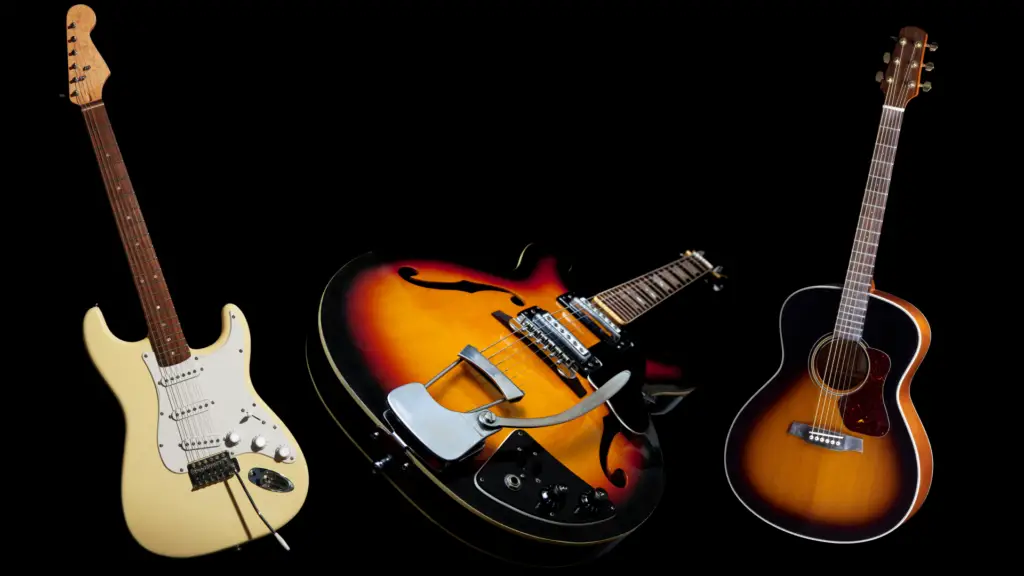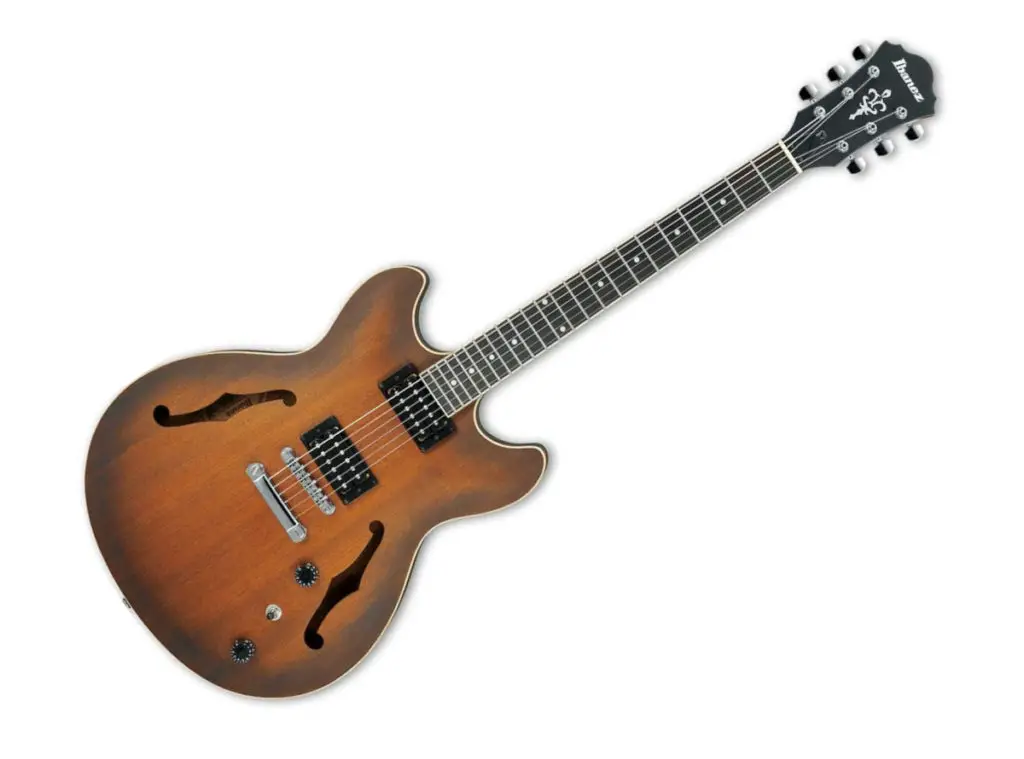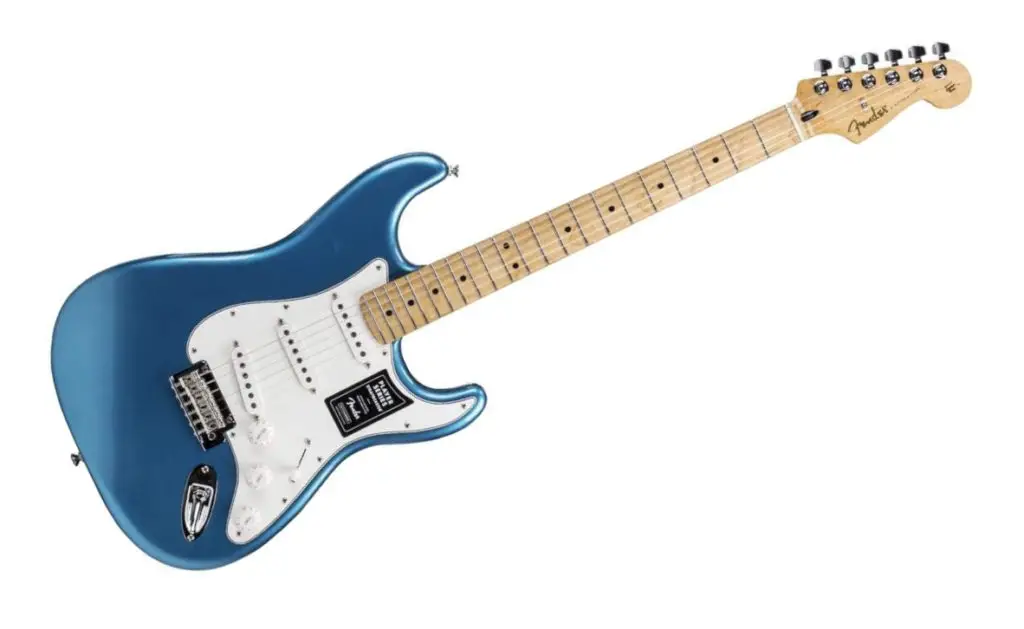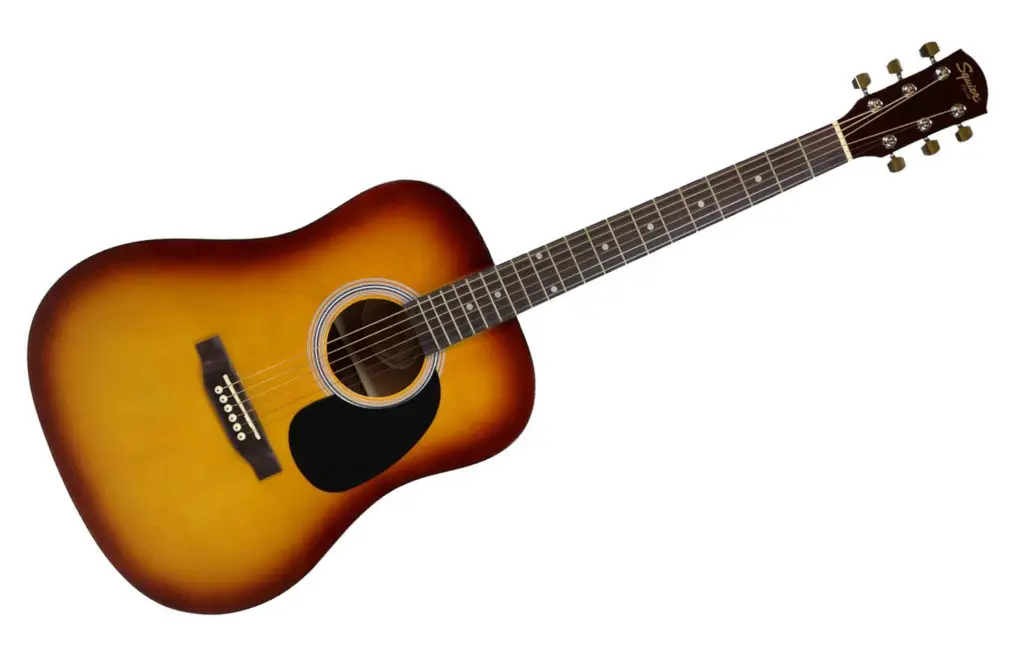Are you in the market for a new guitar?
You might be wondering what the difference is between a semi-hollow body guitar, an acoustic guitar, and a solid body guitar.
Wonder no more – we’re here to break it down for you.

Solid-body and semi-hollow body guitars are electric whereas the acoustic guitar is not.
Solid-body means that the guitar is made entirely out of solid wood with no chambers or holes. Semi-hollow means that the guitar has holes in its body (usually two large ones) and is partially hollow. Acoustic guitars have a hollow body.
So, which is the right guitar for you?
It depends on your needs and preferences. Read on to learn more about the differences between these three types of guitars, as well as the pros and cons of each.
Semi-hollow body guitar vs acoustic vs solid body: what’s the difference?
When it comes to guitars, there are three main types: semi-hollow body, acoustic, and solid body.
Each has its own unique benefits and drawbacks, so it’s important to know which one is right for you.
The main difference between these types of guitars is the sound they produce.
Have you heard a Fender Strat (solid body) and a Squier Starcaster (semi-hollow) in action?
One thing you’ll hear for sure is that they sound different. And part of it has to do with how the guitars are built.
Here’s a quick rundown of the main differences between these three types of guitars:
A solid body guitar is electric and has a solid wood body all the way through. There is no “hole” in the body like you’ll find on a semi-hollow or acoustic guitar.
This gives solid body guitars a lot of sustain and very little feedback because it’s very dense.
A semi-hollow body guitar is electric and has a solid wood body with “f-holes” (or “sound holes”).
These f-holes allow some of the sound to resonate through the body, giving the guitar a warmer, more acoustic tone.
Semi-hollow body guitars still have a lot of sustain, but not as much as a solid body guitar.
Finally, acoustic guitars are not electric and have a hollow wood body. This gives them a very natural sound, but they don’t have as much sustain as electric guitars.
I want to discuss these three guitar body types in more detail now.
Semi-hollow guitar
A semi-hollow guitar is a type of electric guitar that is designed to offer the best of both worlds: the acoustic sound of a hollow body guitar with the added sustain of a solid body guitar.
Semi-hollow guitars have “holes” in the body, which allows some of the sound to resonate through the body and gives the guitar a warmer, more acoustic tone.
These holes are called “f-holes” or “sound holes”.
The most popular semi-hollow guitar is the Gibson ES-335, which was first introduced in 1958.
Other popular semi-hollow guitars include the Gretsch G5420T Electromatic, the Epiphone Casino, and the Ibanez Artcore AS53.

Semi-hollow guitars are a good choice for those who want a mellower sound. They’re often used in jazz and blues.
Semi-hollow body guitars have a bit more volume and resonance than solid body guitars.
The original hollow-body electric guitars had a lot of feedback issues.
So, the semi-hollow body guitar was born by basically putting two solid blocks of wood on either side of the guitar’s body.
This helped to reduce feedback while still allowing some of the acoustic sound to resonate through.
See how all the parts of the instrument come together in the production process:
Pros of the semi-hollow guitar
The main benefit of a semi-hollow body guitar is that it offers the best of both worlds: the acoustic sound of a hollow body guitar with the added sustain of a solid body guitar.
The semi hollow guitar produces a very warm tone as well as a nice resonant sound.
Also, this guitar can handle amplification. Like the solid body, feedback isn’t as much of an issue.
This guitar gives a nice bright and punchy tone, similar to the solid body.
Since there’s a bit less wood in the body, the semi-hollow guitars are lighter and more comfortable to play for long periods of time.
Cons of the semi-hollow guitar
The main drawback of a semi-hollow body guitar is that it doesn’t have as much sustain as a solid body guitar.
Another drawback of a semi-hollow body guitar is that they can be a bit more expensive than solid body guitars.
Although, the semi-hollow doesn’t create that many feedback issues, there are still some problems with the feedback compared to the solid body because of the small holes in the body.
Solid body guitar
The solid body electric guitar is made of solid wood all the way through so there’s no “hole” in the body like you’ll find on an acoustic guitar.
The only parts that are hollowed out for a semi-hollow guitar are where the pickups and controls are placed.
This doesn’t mean that all of the guitar body is made of one single piece of wood, instead, it is several pieces of wood glued and pressed together to create a solid block.
The most popular solid-body guitar is the Fender Stratocaster, which was first introduced in 1954.
Other popular solid-body guitars include the Gibson Les Paul, the Ibanez RG, and the PRS Custom 24.

Solid-body guitars are the most popular type of guitar. They’re versatile and can be used for a variety of genres, from rock to country to metal.
They have a very full sound and are less prone to feedback than semi-hollow body guitars.
Some well-known guitars like the Schechter solid-body strats are the top choice of guitarists who play heavier musical styles.
Players like John Mayer and metal legend Tommy Iommi are known to play solid body guitars and they have their own custom instruments.
Jimi Hendrix also used a solid body to perform ‘Machine Gun’ which would’ve been almost impossible on a hollow body because he needed the greater mass of the instrument to diminish resonance.
Pros of a solid body guitar
Wood density contributes to the sustain and therefore, solid-body guitars have the most sustain of the three body types acoustically.
Because there is no resonating chamber, secondary and tertiary harmonics tend to fade away rapidly while the primary ones continue to resonate when you play a note.
Other considerations, including the different types of wood used and the different types of pickups in the guitar, influence how much longer sustain you can obtain from a solid body.
Solid-body guitars can be amplified louder without fear of feedback when compared to a hollow or semi-hollow body.
They can also be more responsive to the effects.
A denser wood will also give the guitar a heavier sound. If you’re looking for a guitar with a bit more heft to it, a solid body is the way to go.
Since solid body guitars are less susceptible to pickup feedback, the result is a crisper sound.
Also, the low end is tighter and more focused.
The trebly notes tend to sound nicer on solid-body guitars as well.
It’s easier to control the feedback of a solid body guitar compared to a hollow body. Also, you can play the predictable tones better.
Finally, when it comes to design because there are no resonating chambers in the body, it can be crafted into practically any shape or design.
So, if you’re seeking for a unique guitar shape, a solid body guitar might be the way to go.
Cons of a solid body guitar
Some people argue solid body guitars don’t have the acoustic resonance that semi-hollow and hollow body guitars do.
The solid body can’t produce the same rich and warm tones as a hollow body.
Another issue to consider is the weight – a solid body electric guitar is heavier than the semi-hollow or hollow guitar because it’s made of more wood and denser.
Players with back and neck problems might want to consider a lighter guitar such as a semi-hollow or hollow body.
But these days you can find lightweight solid body guitars like the Yamaha Pacifica.
Another disadvantage is that if you want to play unplugged, a solid body won’t project the sound as well as a hollow or semi-hollow since it relies on amplification.
Acoustic hollow body guitar
An acoustic guitar is a type of guitar that is not electric and is perfect for unplugged sessions. The acoustic guitar has a hollow body which gives it a natural sound.
Popular acoustic guitars include the Fender Squier Dreadnought, Taylor GS Mini, and the Yamaha range.

Acoustic guitars are the most traditional type of guitar and the hollow body styles were the first guitars ever made (think back to the classical guitars centuries ago)!
They’re typically used for folk and country music but can also be used for other genres.
Acoustic-electric guitars are also available and these have a piezo pickup or microphone installed in the body so you can amplify the sound.
These guitars have a hollow body with a soundhole.
Pros of hollow body guitars
Acoustic guitars are versatile and can be used for different genres of music. They’re commonly used for live performances because they don’t require an amplifier.
They’re also perfect for unplugged sessions.
If you’re a beginner, an acoustic guitar is a great starter instrument because they’re typically less expensive than electric guitars.
Another advantage is that acoustic guitars are low-maintenance compared to electric guitars – you don’t have to worry about replacing the strings as often and they don’t require as much upkeep.
When it comes to the hollow body, the advantage is that it provides a natural sound and resonance.
Cons of hollow body guitars
Acoustic guitars can be difficult to hear in a band setting because they’re not amplified.
They also tend to have a shorter sustain than electric guitars.
If you’re playing with a band, you might need to use a microphone which can be an extra expense.
The hollow body of an acoustic guitar can also give off feedback if it’s not played with the right amplifier.
What to use each guitar for?
Since solid body guitars are electric guitars, they are used for genres where an electric guitar would be used such as rock, pop, blues, and metal. They can also be used for jazz and fusion.
Semi-hollow guitars, although electric, are going to be used for genres that require a bit more acoustic sound such as blues and jazz. You might also see them being used in country and rock.
When it comes to electric guitar, there’s no real rule you have to follow.
Just because you play jazz doesn’t mean you can’t use a solid body electric guitar. It’s all about what sound you’re going for.
And lastly, acoustic guitars are used for genres that require an acoustic sound such as folk and country but can also be used for pop, rock, and blues.
Then, let’s not forget about classical guitar which is a subgenre of acoustic guitar and also has a hollow body. It is used to perform classical music.
Takeaway
Acoustic guitars have a hollow body, solid guitars have no holes and semi-hollow guitars have soundholes.
A semi-hollow body guitar is perfect for anyone who wants the best of both worlds – the acoustic sound of a hollow body guitar with the added sustain of a solid body guitar.
But what about an acoustic guitar? They’re great for unplugged sessions and are generally more affordable than a semi-hollow body guitar.
Solid-body guitars are perfect for those who want a guitar with great sustain and little feedback.
If you are looking for an acoustic guitar that has the durability of a solid body guitar, have a look at some of the best and sturdy carbon fiber guitars
I'm Joost Nusselder, the founder of Neaera and a content marketer, dad, and love trying out new equipment with guitar at the heart of my passion, and together with my team, I've been creating in-depth blog articles since 2020 to help loyal readers with recording and guitar tips.

